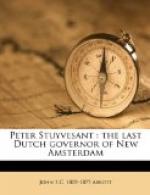It is probable that those in the war canoe, came as a protection for their companions. It is hardly conceivable that the Indians, naturally timid and wary, could have thought, with a single war canoe containing scarcely a dozen men, armed with arrows, to attack the formidable vessel of Sir Henry Hudson, armed, as they well knew it to be, with the terrible energies of thunder and lightning.
The Indians were so unsuspicious of danger, that two of them unhesitatingly came on board. Sir Henry, we must think treacherously, seized them as prisoners, and ordered the canoes containing their companions, to keep at a distance. Soon another canoe came, from another direction, with only two men in it. Sir Henry received them both on board, and seized them also as prisoners. He intended to hold them as hostages, that he might thus protect himself from any hostility on the part of the natives.
One of these men upon finding himself a captive, leaped overboard and swam ashore. Sir Henry had now three prisoners and he guarded them very closely. Yet the natives, either from policy or from fear, made no hostile demonstrations against him.
The half Moon remained in the outer bay nine days. Several exploring tours had been sent out, visiting what is now known as the Jersey shore. None of these, with the exception of the one to which we have alluded, encountered any hostility whatever from the natives.
On the 11th of September, Hudson sailed through the Narrows, and anchored in the still and silent waters of New York harbor. These waters had never then been whitened by a sail, or ploughed by any craft larger than the Indian’s birch canoe. The next morning, the 12th of September, Sir Henry again spread his sails, and commenced his memorable voyage up the solitary river, which has subsequently borne his name. Only here and there could a few wigwams be seen, scattered through the forest, which fringed its banks. But human life was there, then as now, with the joys of the bridal and the grief of the burial. When we contemplate the million of people, now crowded around the mouth of the Hudson, convulsively struggling in all the stern conflicts of this tumultuous life, it may be doubted whether there were not as much real happiness in the wigwam of the Indian as is now to be found in the gorgeous palace of the modern millionaire. And when we contemplate the vices and the crimes which civilization has developed, it may also be doubted whether, there were not as much virtue, comparatively with the numbers to be found, within the bark hut of the red man, as is now to be found in the abodes of the more boastful white man.
Sir Henry Hudson hoped to find this majestic river, inviting him into unknown regions of the north, to be an arm of the sea through which he could cross the continent to the shores of the Pacific. It was not then known whether this continent were a few miles or thousands of miles in breadth. For the first two days the wind was contrary, and the Half Moon ascended the river but about two miles. The still friendly natives paddled out from the shores, in their bark canoes in great numbers, coming on board entirely unarmed and offering for sale, excellent oysters and vegetables in great abundance.




